nth root
In mathematics, an nth root of a number x, where n is usually assumed to be a positive integer, is a number r which, when raised to the power n yields x:
where n is the degree of the root. A root of degree 2 is called a square root and a root of degree 3, a cube root. Roots of higher degree are referred by using ordinal numbers, as in fourth root, twentieth root, etc.
The computation of an nth root is a root extraction.
For example:
- 3 is a square root of 9, since 32 = 9.
- −3 is also a square root of 9, since (−3)2 = 9.
Any non-zero number considered as a complex number has n different complex nth roots, including the real ones (at most two). The nth root of 0 is zero for all positive integers n, since 0n = 0. In particular, if n is even and x is a positive real number, one of its nth roots is real and positive, one is negative, and the others (when n > 2) are non-real complex numbers; if n is even and x is a negative real number, none of the nth roots is real. If n is odd and x is real, one nth root is real and has the same sign as x, while the other (n – 1) roots are not real. Finally, if x is not real, then none of its nth roots are real.
Roots of real numbers are usually written using the radical symbol or radix with denoting the positive square root of x if x is positive, and denoting the real nth root, if n is odd, and the positive square root if n is even and x is nonnegative. In the other cases, the symbol is not commonly used as being ambiguous. In the expression , the integer n is called the index, is the radical sign or radix, and x is called the radicand.
When complex nth roots are considered, it is often useful to choose one of the roots as a principal value. The common choice is the one that makes the nth root a continuous function that is real and positive for x real and positive. More precisely, the principal nth root of x is the nth root, with the greatest real part, and, when there are two (for x real and negative), the one with a positive imaginary part.
A difficulty with this choice is that, for a negative real number and an odd index, the principal nth root is not the real one. For example, has three cube roots, , and The real cube root is and the principal cube root is
An unresolved root, especially one using the radical symbol, is sometimes referred to as a surd[1] or a radical.[2] Any expression containing a radical, whether it is a square root, a cube root, or a higher root, is called a radical expression, and if it contains no transcendental functions or transcendental numbers it is called an algebraic expression.
Roots can also be defined as special cases of exponentiation, where the exponent is a fraction:
Roots are used for determining the radius of convergence of a power series with the root test. The nth roots of 1 are called roots of unity and play a fundamental role in various areas of mathematics, such as number theory, theory of equations, and Fourier transform.
Definition and notation
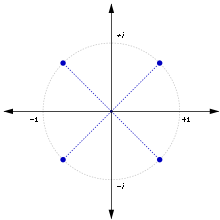
none of which are real
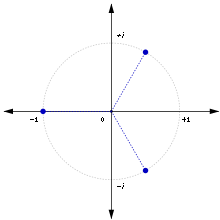
one of which is a negative real
An nth root of a number x, where n is a positive integer, is any of the n real or complex numbers r whose nth power is x:
Every positive real number x has a single positive nth root, called the principal nth root, which is written . For n equal to 2 this is called the principal square root and the n is omitted. The nth root can also be represented using exponentiation as x1/n.
For even values of n, positive numbers also have a negative nth root, while negative numbers do not have a real nth root. For odd values of n, every negative number x has a real negative nth root. For example, −2 has a real 5th root, but −2 does not have any real 6th roots.
Every non-zero number x, real or complex, has n different complex number nth roots. (In the case x is real, this count includes any real nth roots.) The only complex root of 0 is 0.
The nth roots of almost all numbers (all integers except the nth powers, and all rationals except the quotients of two nth powers) are irrational. For example,
All nth roots of integers are algebraic numbers.
The term surd traces back to al-Khwārizmī (c. 825), who referred to rational and irrational numbers as audible and inaudible, respectively. This later led to the Arabic word "أصم" (asamm, meaning "deaf" or "dumb") for irrational number being translated into Latin as "surdus" (meaning "deaf" or "mute"). Gerard of Cremona (c. 1150), Fibonacci (1202), and then Robert Recorde (1551) all used the term to refer to unresolved irrational roots.[5]
Square roots
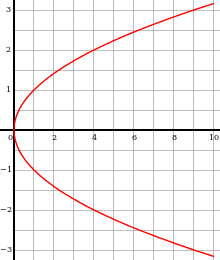
A square root of a number x is a number r which, when squared, becomes x:
Every positive real number has two square roots, one positive and one negative. For example, the two square roots of 25 are 5 and −5. The positive square root is also known as the principal square root, and is denoted with a radical sign:
Since the square of every real number is a positive real number, negative numbers do not have real square roots. However, for every negative real number there are two imaginary square roots. For example, the square roots of −25 are 5i and −5i, where i represents a number whose square is −1.
Identities and properties
Expressing the degree of an nth root in its exponent form, as in , makes it easier to manipulate powers and roots.
Every positive real number has exactly one positive real nth root, and so the rules for operations with surds involving positive radicands are straightforward within the real numbers:
Subtleties can occur when taking the nth roots of negative or complex numbers. For instance:
- but rather
Since the rule strictly holds for non-negative real radicands only, its application leads to the inequality in the first step above.
Simplified form of a radical expression
A non-nested radical expression is said to be in simplified form if[6]
- There is no factor of the radicand that can be written as a power greater than or equal to the index.
- There are no fractions under the radical sign.
- There are no radicals in the denominator.
For example, to write the radical expression in simplified form, we can proceed as follows. First, look for a perfect square under the square root sign and remove it:
Next, there is a fraction under the radical sign, which we change as follows:
Finally, we remove the radical from the denominator as follows:
When there is a denominator involving surds it is always possible to find a factor to multiply both numerator and denominator by to simplify the expression.[7][8] For instance using the factorization of the sum of two cubes:
Simplifying radical expressions involving nested radicals can be quite difficult. It is not obvious for instance that:
The above can be derived through:
Infinite series
The radical or root may be represented by the infinite series:
with . This expression can be derived from the binomial series.
Computing principal roots
The nth root of an integer k is only an integer if k is the product of nth powers of integers. In all other cases the nth root of an integer is an irrational number. For instance, the fifth root of 248832 is
and the fifth root of 34 is
where here the dots signify not only that the decimal expression does not end after a finite number of digits, but also that the digits never enter a repeating pattern, because the number is irrational.
Since for positive real numbers a and b the equality holds, the above property can be extended to positive rational numbers. Let , with p and q coprime and positive integers, be a rational number, then r has a rational nth root, if both positive integers p and q have an integer nth root, i.e., is the product of nth powers of rational numbers. If one or both nth roots of p or q are irrational, the quotient is irrational, too.
Using Newton's method
The nth root of a number A can be computed with Newton's method. Start with an initial guess x0 and then iterate using the recurrence relation
until the desired precision is reached.
Depending on the application, it may be enough to use only the first Newton approximant:
For example, to find the fifth root of 34, note that 25 = 32 and thus take x = 2, n = 5 and y = 2 in the above formula. This yields
The error in the approximation is only about 0.03%.
Newton's method can be modified to produce a generalized continued fraction for the nth root which can be modified in various ways as described in that article. For example:
In the case of the fifth root of 34 above (after dividing out selected common factors):
Digit-by-digit calculation of principal roots of decimal (base 10) numbers
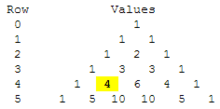
Building on the digit-by-digit calculation of a square root, it can be seen that the formula used there, , or , follows a pattern involving Pascal's triangle. For the nth root of a number is defined as the value of element in row of Pascal's Triangle such that , we can rewrite the expression as . For convenience, call the result of this expression . Using this more general expression, any positive principal root can be computed, digit-by-digit, as follows.
Write the original number in decimal form. The numbers are written similar to the long division algorithm, and, as in long division, the root will be written on the line above. Now separate the digits into groups of digits equating to the root being taken, starting from the decimal point and going both left and right. The decimal point of the root will be above the decimal point of the radicand. One digit of the root will appear above each group of digits of the original number.
Beginning with the left-most group of digits, do the following procedure for each group:
- Starting on the left, bring down the most significant (leftmost) group of digits not yet used (if all the digits have been used, write "0" the number of times required to make a group) and write them to the right of the remainder from the previous step (on the first step, there will be no remainder). In other words, multiply the remainder by and add the digits from the next group. This will be the current value c.
- Find p and x, as follows:
- Let be the part of the root found so far, ignoring any decimal point. (For the first step, ).
- Determine the greatest digit such that .
- Place the digit as the next digit of the root, i.e., above the group of digits you just brought down. Thus the next p will be the old p times 10 plus x.
- Subtract from to form a new remainder.
- If the remainder is zero and there are no more digits to bring down, then the algorithm has terminated. Otherwise go back to step 1 for another iteration.
Examples
Find the square root of 152.2756.
1 2. 3 4
/
\/ 01 52.27 56
01 100·1·00·12 + 101·2·01·11 ≤ 1 < 100·1·00·22 + 101·2·01·21 x = 1
01 y = 100·1·00·12 + 101·2·01·12 = 1 + 0 = 1
00 52 100·1·10·22 + 101·2·11·21 ≤ 52 < 100·1·10·32 + 101·2·11·31 x = 2
00 44 y = 100·1·10·22 + 101·2·11·21 = 4 + 40 = 44
08 27 100·1·120·32 + 101·2·121·31 ≤ 827 < 100·1·120·42 + 101·2·121·41 x = 3
07 29 y = 100·1·120·32 + 101·2·121·31 = 9 + 720 = 729
98 56 100·1·1230·42 + 101·2·1231·41 ≤ 9856 < 100·1·1230·52 + 101·2·1231·51 x = 4
98 56 y = 100·1·1230·42 + 101·2·1231·41 = 16 + 9840 = 9856
00 00 Algorithm terminates: Answer is 12.34
Find the cube root of 4192 to the nearest hundredth.
1 6. 1 2 4 3 / \/ 004 192.000 000 000
004 100·1·00·13 + 101·3·01·12 + 102·3·02·11 ≤ 4 < 100·1·00·23 + 101·3·01·22 + 102·3·02·21 x = 1
001 y = 100·1·00·13 + 101·3·01·12 + 102·3·02·11 = 1 + 0 + 0 = 1
003 192 100·1·10·63 + 101·3·11·62 + 102·3·12·61 ≤ 3192 < 100·1·10·73 + 101·3·11·72 + 102·3·12·71 x = 6
003 096 y = 100·1·10·63 + 101·3·11·62 + 102·3·12·61 = 216 + 1,080 + 1,800 = 3,096
096 000 100·1·160·13 + 101·3·161·12 + 102·3·162·11 ≤ 96000 < 100·1·160·23 + 101·3·161·22 + 102·3·162·21 x = 1
077 281 y = 100·1·160·13 + 101·3·161·12 + 102·3·162·11 = 1 + 480 + 76,800 = 77,281
018 719 000 100·1·1610·23 + 101·3·1611·22 + 102·3·1612·21 ≤ 18719000 < 100·1·1610·33 + 101·3·1611·32 + 102·3·1612·31 x = 2
015 571 928 y = 100·1·1610·23 + 101·3·1611·22 + 102·3·1612·21 = 8 + 19,320 + 15,552,600 = 15,571,928
003 147 072 000 100·1·16120·43 + 101·3·16121·42 + 102·3·16122·41 ≤ 3147072000 < 100·1·16120·53 + 101·3·16121·52 + 102·3·16122·51 x = 4
The desired precision is achieved:
The cube root of 4192 is about 16.12
Logarithmic calculation
The principal nth root of a positive number can be computed using logarithms. Starting from the equation that defines r as an nth root of x, namely with x positive and therefore its principal root r also positive, one takes logarithms of both sides (any base of the logarithm will do) to obtain
The root r is recovered from this by taking the antilog:
(Note: That formula shows b raised to the power of the result of the division, not b multiplied by the result of the division.)
For the case in which x is negative and n is odd, there is one real root r which is also negative. This can be found by first multiplying both sides of the defining equation by −1 to obtain then proceeding as before to find |r|, and using r = −|r|.
Geometric constructibility
The ancient Greek mathematicians knew how to use compass and straightedge to construct a length equal to the square root of a given length. In 1837 Pierre Wantzel proved that an nth root of a given length cannot be constructed if n is not a power of 2.[9]
Complex roots
Every complex number other than 0 has n different nth roots.
Square roots
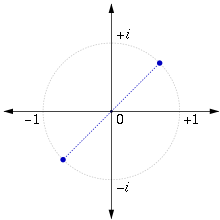
The two square roots of a complex number are always negatives of each other. For example, the square roots of −4 are 2i and −2i, and the square roots of i are
If we express a complex number in polar form, then the square root can be obtained by taking the square root of the radius and halving the angle:
A principal root of a complex number may be chosen in various ways, for example
which introduces a branch cut in the complex plane along the positive real axis with the condition 0 ≤ θ < 2π, or along the negative real axis with −π < θ ≤ π.
Using the first(last) branch cut the principal square root maps to the half plane with non-negative imaginary(real) part. The last branch cut is presupposed in mathematical software like Matlab or Scilab.
Roots of unity

The number 1 has n different nth roots in the complex plane, namely
where
These roots are evenly spaced around the unit circle in the complex plane, at angles which are multiples of . For example, the square roots of unity are 1 and −1, and the fourth roots of unity are 1, , −1, and .
nth roots

Every complex number has n different nth roots in the complex plane. These are
where η is a single nth root, and 1, ω, ω2, ... ωn−1 are the nth roots of unity. For example, the four different fourth roots of 2 are
In polar form, a single nth root may be found by the formula
Here r is the magnitude (the modulus, also called the absolute value) of the number whose root is to be taken; if the number can be written as a+bi then . Also, is the angle formed as one pivots on the origin counterclockwise from the positive horizontal axis to a ray going from the origin to the number; it has the properties that and
Thus finding nth roots in the complex plane can be segmented into two steps. First, the magnitude of all the nth roots is the nth root of the magnitude of the original number. Second, the angle between the positive horizontal axis and a ray from the origin to one of the nth roots is , where is the angle defined in the same way for the number whose root is being taken. Furthermore, all n of the nth roots are at equally spaced angles from each other.
If n is even, a complex number's nth roots, of which there are an even number, come in additive inverse pairs, so that if a number r1 is one of the nth roots then r2 = –r1 is another. This is because raising the latter's coefficient –1 to the nth power for even n yields 1: that is, (–r1)n = (–1)n × r1n = r1n.
As with square roots, the formula above does not define a continuous function over the entire complex plane, but instead has a branch cut at points where θ / n is discontinuous.
Solving polynomials
It was once conjectured that all polynomial equations could be solved algebraically (that is, that all roots of a polynomial could be expressed in terms of a finite number of radicals and elementary operations). However, while this is true for third degree polynomials (cubics) and fourth degree polynomials (quartics), the Abel–Ruffini theorem (1824) shows that this is not true in general when the degree is 5 or greater. For example, the solutions of the equation
cannot be expressed in terms of radicals. (cf. quintic equation)
Proof of irrationality for non-perfect nth power x
Assume that is rational. That is, it can be reduced to a fraction , where a and b are integers without a common factor.
This means that .
Since x is an integer, and must share a common factor if . This means that if , is not in simplest form. Thus b should equal 1.
Since and , .
This means that and thus, . This implies that is an integer. Since x is not a perfect nth power, this is impossible. Thus is irrational.
See also
References
- Bansal, R.K. (2006). New Approach to CBSE Mathematics IX. Laxmi Publications. p. 25. ISBN 978-81-318-0013-3.
- Silver, Howard A. (1986). Algebra and trigonometry. Englewood Cliffs, NJ: Prentice-Hall. ISBN 978-0-13-021270-2.
- "Definition of RADICATION". www.merriam-webster.com.
- "radication – Definition of radication in English by Oxford Dictionaries". Oxford Dictionaries.
- "Earliest Known Uses of Some of the Words of Mathematics". Mathematics Pages by Jeff Miller. Retrieved 2008-11-30.
- McKeague, Charles P. (2011). Elementary algebra. p. 470. ISBN 978-0-8400-6421-9.
- B.F. Caviness, R.J. Fateman, "Simplification of Radical Expressions", Proceedings of the 1976 ACM Symposium on Symbolic and Algebraic Computation, p. 329.
- Richard Zippel, "Simplification of Expressions Involving Radicals", Journal of Symbolic Computation 1:189–210 (1985) doi:10.1016/S0747-7171(85)80014-6.
- Wantzel, M. L. (1837), "Recherches sur les moyens de reconnaître si un Problème de Géométrie peut se résoudre avec la règle et le compas", Journal de Mathématiques Pures et Appliquées, 1 (2): 366–372.
External links
| Look up surd in Wiktionary, the free dictionary. |
| Look up radical in Wiktionary, the free dictionary. |
